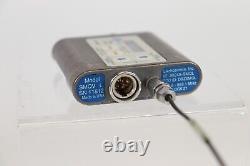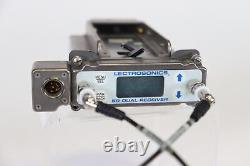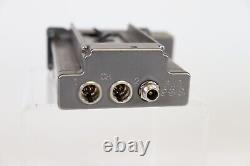Lectrosonics SMQV Miniature Wireless Transmitter + SRb Receiver, Block 21







The Lectrosonics SMQV Super Miniature Wireless Microphone Transmitter incorporates Lectrosonics patented Digital Hybrid Wireless technology, in a package no bigger than a pager. The SMQV transmitter is miniature in size yet rugged enough to withstand rigorous daily use in the field or in studios. To meet the demand for both extended operating range and extended battery life, the SMQV transmitters offer selectable output power of 50, 100 or 250 mW. A third selection at 50 mW is provided for some theatrical applications, where the system design specifies lower transmitter power. The SMQV transmitter offers 256 user-selectable UHF frequencies. The Switchcraft TA5M audio input has user-calibrated 44 dB gain range, and accepts electret lavaliere mics, dynamic mics, or line level signals.
A DSP-controlled analog audio limiter is employed before the A-D converter. The limiter has a range of more than 30 dB and a dual-release envelope, making the limiter transparent while maintaining low distortion. Lectrosonics patented Digital Hybrid technology revolutionizes wireless microphone transmission. Digital audio signal is converted and encoded for analog transmission, then decoded and converted back to digital audio at the receiver.
The result is an exceptionally low noise floor as the compandor circuit is eliminated and clear audio reception is retained at greater distances. The non-corrosive, machined aluminum casing is splash proof and features an LCD display with membrane switch control panel. The transmitter is powered by two AA lithium, NiMH or alkaline batteries for up to 14.5 hours (lithium).The SMQV transmitter is completely compatible with all Lectrosonics Digital Hybrid wireless receivers, as well as older Lectrosonics analog receivers. The SMQV features selectable 50, 100 or 250 mW output power. The miniature design allows for a variety of mounting possibilities in film, video, theater, performances, etc. Lectrosonics incorporates digital and analog audio technology to enhance range and eliminate the noise associated with compandor circuits. A locking TA5M input is compatible with Lectrosonics and third-party microphones and cables.
The input accepts line and microphone level signal. The SMQV transmitter is completely compatible with all current Lectrosonics Digital Hybrid receivers and older Lectrosonics analog receiver models as well.
The polished aluminum enclosure is moisture proof and ideal for use in rain. The SMQV transmitter is powered by two AA alkaline, NiMH or lithium rechargeable batteries. With Lithium power, the unit is capable of up to 14.5 hours of use. The Lectrosonics SRb Camera Slot UHF Receiver (Block 21) is a two-channel slot-mount Digital Hybrid Wireless diversity receiver that supports 537.600 - 563.100 MHz operating frequencies.
The SRb receiver offers two independent channels and fits into the standard video camera slots found on professional cameras. The two audio channels can feed separate inputs or can be mixed internally to feed a single input. Plus, a DSP compatibility mode allows the SRb to be used with Lectrosonics IFB transmitters. The device's RF performance is extremely stable over a very wide temperature range, making the receiver well suited for the rough environmental conditions found in field production.
The front panel features a menu-driven LCD interface and four membrane switches which are used to view and alter settings. The main LCD window displays the pilot tone indicator, diversity activity, RF level, audio level and transmitter battery status for both receivers. Other features include SmartSquelch for noiseless muting and a built-in spectrum analyzer that scans across the tuning range of the receiver to locate RF signals in the vicinity and find clear operating frequencies.
The two internal receivers can be operated separately, each using switching, antenna combining diversity, or in tandem with ratio diversity reception. Clear frequencies are easily found with the built-in RF spectrum scanner and graphical LCD. The audio outputs of the receivers can be mixed internally, or left separated for discrete recording tracks or external mixing.
Digital Hybrid Wireless is a design that combines digital audio with an analog FM radio link to provide both high audio quality and noise-free RF performance. Using a patented algorithm to encode 24-bit digital audio information in the transmitter into an analog format, the encoded signal is then transmitted over an analog FM wireless link. At the receiver, the signal is then decoded to restore the original digital audio. This process eliminates compandor artifacts and produces an audio frequency response flat to 20 kHz. Each antenna signal is first passed through a high quality SAW filter to reject high power RF signals above and below the operating frequency. A high current amplifier follows the SAW filters and passes the signal to an internal splitter so that both antenna signals are available to both receivers for SmartDiversity reception. The wide dynamic range of digital hybrid technology with a flat response to 20 kHz makes it possible to hear the -120 dBV noise floor in the mic preamp, or the (usually) greater noise from the microphone itself. To put this in perspective, the noise generated by the recommended 4k bias resistor of many electret lavaliere mics is -119 dBV and the noise level of the microphone's electronics is even higher. In order to reduce this noise a Smart Noise Reduction algorithm is used to remove hiss without sacrificing audio high frequency response.The SmartNR algorithm preserves the transparency of the audio signal. Plus, desired high frequency signals are not affected. The SmartNR algorithm has three modes, selectable from a user setup screen. The optimal setting for each application is subjective and selected while simply listening.
The first IF stage at 244 MHz employs two state-of-the-art SAW (surface acoustic wave) filters that increase depth of filtering while preserving sharp skirts, constant group delay and wide bandwidth. This type of filter allows early primary filtering at a high frequency, before high gain is applied, to deliver maximum image rejection.
The filters are made of quartz as well, which makes them very temperature stable. After the SAW filter, the 244 MHz IF signal is converted to 250 kHz in receiver 1 and 350 kHz in receiver 2. Only then is the majority of the gain applied, just before the signal is converted to audio. The SRb Series receivers use a simple, yet effective digital pulse detector to demodulate the FM signal rather than a conventional quadrature detector.
Supersonic Noise-Based Dynamic Filter & Squelch. In addition to SmartNR, all hybrid receivers are equipped with a supersonic noise-based dynamic filter and squelch system. The incoming audio is monitored for energy above 22 kHz, pilot tone excepted. Excessive high frequency energy indicates that the received signal is too weak to achieve an acceptable signal-to-noise ratio. Under marginal conditions, a variable low pass filter is rolled in dynamically, masking the noise while preserving as much of the transmitted signal as possible.
When the channel is too noisy even for the filter, the audio is squelched. Plus, unlike analog squelching, this noise-based system requires no calibration and there is no better way to track the signal-to-noise ratio than to measure it directly. The SRb Series receivers are designed to remove distracting noise without the squelching action itself becoming a distraction. They use a technique that waits for a word or syllable to be completed before squelching. Another technique incorporates recent squelching history and recent signal strength, adjusting squelching behavior dynamically for the most serviceable result under variable conditions. Using these and other techniques, the receivers can deliver acceptable audio quality from otherwise unusable signals. The Talkback function provides a second audio channel separate from the main audio channel to allow the user to communicate with staff and crew. When the button on the housing is pressed, the audio output on the receiver is switched to a different output jack. This item is in the category "Cameras & Photo\Video Production & Editing\Audio for Video". The seller is "trewaudio" and is located in this country: US. This item can be shipped to United States, Canada.- Model: SMQV
- Type: Transmitter
- Brand: Lectrosonics


